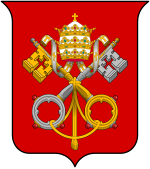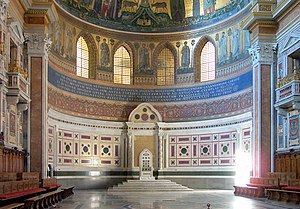Diocese of Rome
Diocese of Rome Dioecesis Urbis | |
|---|---|
 | |
| Location | |
| Country | Italy |
| Territory | Rome |
| Ecclesiastical province | Rome |
| Metropolitan | Diocese of Rome |
| Coordinates | 41°53′9.26″N 12°30′22.16″E / 41.8859056°N 12.5061556°E |
| Statistics | |
| Area | 881 km2 (340 sq mi) |
| Population - Total - Catholics | (as of 2007) 2,809,000 2,473,000 (88%) |
| Parishes | 337 |
| Churches | 711 |
| Information | |
| Denomination | Roman Catholic |
| Rite | Latin Rite |
| Established | 1st century |
| Cathedral | Papal Archbasilica of St. John Lateran |
| Patron saint | Saints Peter and Paul, St. Catherine of Siena, St. Philip Neri, St. Lawrence |
| Secular priests | 5,994 |
| Current leadership | |
| Pope | Pope Francis I |
| Bishop | Pope Francis I |
| Metropolitan Archbishop | Pope Francis I |
| Auxiliary Bishops | Filippo Iannone, Paolino Schiavon, Guerino Di Tora, Giuseppe Marciante, Lorenzo Leuzzi, Matteo Maria Zuppi |
| Vicar General | Agostino Vallini, Angelo Comastri |
| Bishops emeritus | Pope Emeritus Benedict XVI |
| Website | |
| vicariatusurbis.org | |
| Source: Annuario Pontificio 2012 | |
The Diocese of Rome (Latin: Dioecesis Urbis seu Romana,[1] Italian: Diocesi di Roma) is a diocese of the Catholic Church in Rome, Italy.[2] Its bishop is known as the Pope, and is the Supreme Pontiff and leader of the Catholic Church. Established in the 1st century, the Bishop of Rome is Pope Francis I from 13 March 2013.
Bishop
The bishop of the Diocese of Rome has, in the first place, the title of Bishop of Rome, the basis for all his other titles. Those officially listed for him are:
- Vicar of Jesus Christ
- Successor of the Prince of the Apostles
- Supreme Pontiff of the Universal Church
- Primate of Italy, as his see is the most distinguished of the Church in Italy
- Metropolitan and Archbishop of the Ecclesiastical Province of Rome
- Sovereign of the State of Vatican City since its establishment by the Lateran Treaty in 1929
- Servant of the Servants of God
Origins
The best evidence available for the origins of the Church in Rome is Saint Paul's Epistle to the Romans. This indicates that the church was established probably by the early 40s. Saint Peter became associated with this church sometime between the year 58 and the early 60s.[3]
Says one source:
- The final years of the first century and the early years of the second constitute the "postapostolic" period, as reflected in the extrabiblical writings of Clement of Rome and Ignatius of Antioch. By now the church at Rome was exercising a pastoral care that extended beyond its own community, having replaced Jerusalem as the practical center of the growing universal Church. Appeals were made to Peter and Paul, with whom the Roman church was most closely identified.[3]
Diocese

The territory of the diocese includes Vatican City State and the city of Rome, capital of the Italian Republic, with distinct vicars general for the two parts:
- Vicariate of Rome (Latin: Vicariatus urbis), the territory under Italian sovereignty and including the Basilica of St. John Lateran, which is the cathedral of the diocese. The current Cardinal Vicar (Italian: Cardinale Vicario) is Agostino Vallini.
- Vicariate of the Vatican City, the territory of Vatican City State, including Saint Peter's Basilica. It consists of one parish, that of Saint Anne in Vatican.[4] The current vicar general is Angelo Comastri.
Unless the bishop of a diocese reserves some acts to himself, vicars general have within a diocese the power to place all administrative acts that belong to the bishop except those that in law require a special mandate of the bishop.[5]
The diocese covers a territory of 881 square kilometers[6] The website of the Vicariate of Rome lists 335 active and 5 suppressed parishes in its territory[7] In addition there are two parishes in Vatican City.[8][9] The diocese of Rome has 1219 diocesan priests of its own, while 2331 priests of other dioceses, 5072 religious priests and 140 Opus Dei priests reside in its territory, as do 2266 women religious.[10] In 2004, they pastored an estimated 2,454,000 faithful, who made up 88% of the population of the territory.
The city of Rome has grown beyond the boundaries of the diocese. Notable parts of the city belong to the dioceses of Ostia and Porto-Santa Rufina. Ostia is administered together with the Vicariate of the City and thus included in the statistics given above, while Porto is instead administered by its own residential bishop.
Suburbicarian sees
Six of the dioceses of the Roman Province are described as suburbicarian.[11] Each suburbicarian diocese has a Cardinal Bishop at its head.
- Suburbicarian See of Porto-Santa Rufina
- Suburbicarian See of Albano
- Suburbicarian See of Frascati
- Suburbicarian See of Palestrina
- Suburbicarian See of Sabina-Poggio Mirteto
- Suburbicarian See of Velletri-Segni
Diocese of Ostia
There remains the titular Suburicarian See of Ostia, held, in addition to his previous suburbicarian see, by the Cardinal Bishop elected to be the Dean of the College of Cardinals. The Diocese of Ostia was merged with the Diocese of Rome in 1914, and is now administered by the Vicar General for Rome.
Suffragan sees
Other dioceses that have Rome as their metropolitan see:
- Archdiocese of Gaeta
- Diocese of Anagni-Alatri
- Diocese of Civita Castellana
- Diocese of Civitavecchia-Tarquinia
- Diocese of Frosinone-Veroli-Ferentino
- Diocese of Latina-Terracina-Sezze-Priverno
- Diocese of Rieti
- Diocese of Sora-Aquino-Pontecorvo
- Diocese of Tivoli
- Diocese of Viterbo
- Territorial Abbey of Montecassino
- Territorial Abbey of Subiaco
Ordinaries
For a chronological list of popes, see List of Popes.
See also
- List of Roman Catholic dioceses (alphabetical) (including archdioceses)
- List of Roman Catholic dioceses (structured view) (including archdioceses)
- List of Roman Catholic archdioceses (by country and continent)
References
- ^ {Annuario Pontificio 2012, p. 1
- ^ Catholic Encyclopedia article: Rome
- ^ a b McBrien, The Church (New York: HarperOne, 2008) cf pp 6, 45
- ^ Diocesi di Roma. "Vicariato della Città del Vaticano" (in Italian). Retrieved 16 November 2010.
- ^ "Canon 479 §1". Code of Canon Law. Retrieved 2012-03-31.
- ^ Entry at catholic-hierarchy.org
- ^ Vicariate of Rome: Parishes
- ^ Annuario Pontificio 2012, p. 1386
- ^ Vicariate of Rome: Vicariate of Vatican City
- ^ Vicariate of Rome: Personnel. Retrieved 2012-03-31
- ^ For the etymology of this word, see Etymology of the English word suburbicarian
External links
- Official website of the Vicariate of Rome
- Official website of the Holy See
- Diocese of Roma on Catholic-hierarchy.org
- Diocese of Rome on Gcatholic.org
